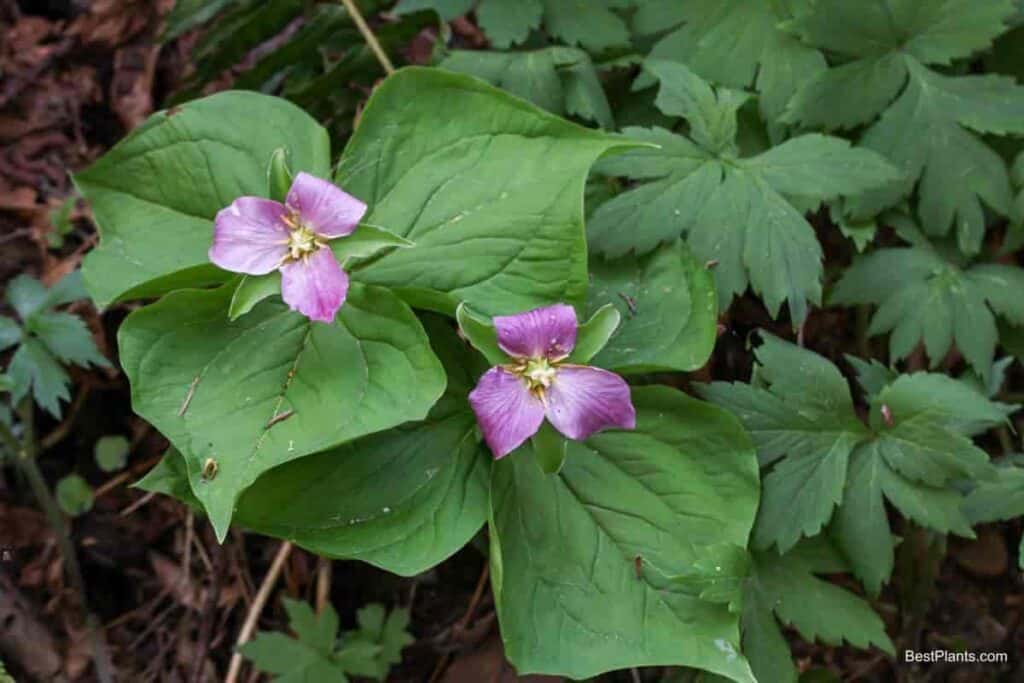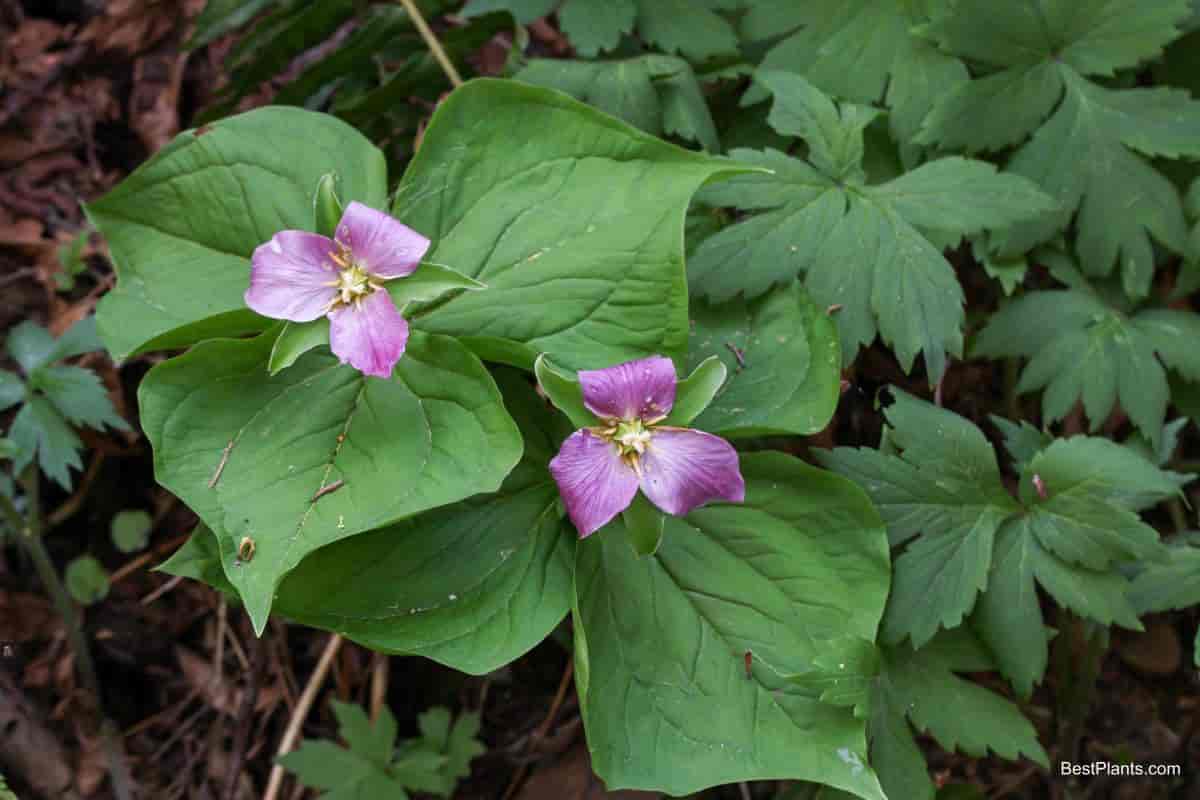Trillium cernuum, the nodding trillium, is a comparatively tall sort, growing to the size of the snow trillium, but with a much smaller white flower that droops and is often hidden below the three broad green leaves.
It is particularly fond of sandy, acid soils and may be found in the neighborhood of scrub pines in more southern New England, though not in dense pine land.

In the north, it grows in certain areas known to be deficient in limestone, and this characteristic liking for acidity would likely govern its successful cultivation in the garden. However, it has never given any difficulty when planted under the conditions previously outlined.
It is never found in masses, although likely to be scattered over a sloping area in considerable numbers. I recommend it to those who garden on the edge of the sandy regions with a sprinkling of pine trees, and I would keep it from cold clay loams, especially if not well drained.
The Painted Trillium
Trillium undulatum, the painted trillium, is undoubtedly the most northern sort, being found as far north as Nova Scotia. Its liking for cold is best shown by the fact that even in Vermont, it is rarely found below an altitude of 500 feet, though I know several notable exceptions to this rule.
It is scattered all over the sloping sides of the Green Mountains in open deciduous woodland; it grows in various kinds of soil but seems to like the gravelly, relatively empty, and well-drained types best.
The plant is tall, often 2′ feet high, and the flower, quite a good size, is white, striped, and sometimes profoundly blotched with purple.
It does not always droop, as does the nodding trillium, and often when a bit of woodland is filled with them so that a good number open their buds simultaneously, they make an outstanding showing.
Like all trilliums, this one has large red fruit, and it seems to be quite usual or it to develop so that there is a long display of color. The species grow at a depth of from 6 inches to nearly a foot, and digging one is a significant operation.
Invariably, they choose between two buttressed roots of a good-sized tree or soil matted with feeding roots of trees and shrubs.
Here they hide with the taller foliage of medeola or cucumber-root ferns and lycopodium, giving them the astonishing root run they like as the summer comes on. Never foiled in large masses, they are plentiful in any woodland where they are at home.
I would not mass them in the garden but would scatter them irregularly at the edge of shrubs or taller trees, where they would get a bit of morning sun but never the total rays of the afternoon. I would plant them 6 inches deep and keep a leaf mulch over them.
The Purple Trillium
Trillium erectum, the purple trillium, also called wake-robin and carrion flower is almost the family’s best known. It is found from Nova Scotia south to Tennessee, but while it is one of the best known, it is not always the best-loved.
I can recall to this day the expression and words of a somewhat disagreeable and highly inquisitive lady, unfamiliar with wildflowers, who was handed a large bouquet of them by a practical joker with the command, “Smell!”
Smell she did sincerely, and I doubt if she ever forgave the giver or looked favorably on the flower. The ill-smelling flower is lovely in its native habitat or when used in the perennial border.
This species is easily cultivated and is permanent and disease-free.
Not as tall as the others, it nevertheless has the most extensive foliage of them all, and it is so lush and rich when it opens its leaves to the earliest spring sun that one can forgive its odor when confined.
This species also sets fruit readily; the three-sided berry is bright red and very showy. It is found everywhere in open woodland, often on the dryer slopes but frequently on a damp hillside of broken stone or hobnobbing with maidenhair fern and Jack-in-the-pulpit at the foot of that same hillside.
It can stand the presence of some hemlocks, though it isn’t likely to be found where they grow thickly. In cultivation, it has no particular choices as to soil and needs only some shade during the beat of the afternoon.
The brown or brown-purple flower is held erectly, sometimes as much as 4” inches above the foliage.
There are several color forms of this trillium. Strangely, perhaps, most of these come from the southern range. The white paper is relatively common in the Appalachians and is quickly cultivated, making a pleasant contrast with the deeper colored type.
There are also greenish purple forms, while from Pennsylvania some years ago came a root of one with doubled flowers with ten segments of a pale green color lightly striped with white.
Though not beautiful, this one was compelling evidence of the strange forms nature can produce under certain conditions.
Several times in Vermont, I’ve seen plants with six leaves instead of the three that give the group its name. But color variations there are none, so far as I know, though perhaps some who have tramped our hills may have found them; if they have, they have not been reported.
The Snow Trillium
I come at last to Trillium grandiflorum, the snow trillium, the great white trillium, the moose-flower of early Vermont writers. No doubt it still has other names throughout its range, from Quebec to North Carolina and Missouri.
As I have already hinted, it grows in unbelievable profusion in any bit of damp, open woodland which is not heavily pastured by cattle. It is found scattered in small groups, or singly, almost everywhere in our May woods.
Its profusion in the Champlain Valley of Vermont indicates a liking for that region’s somewhat alkaline soils and soil waters. But the grounds, though underlain with a limerick, are often slightly acid. For that matter, I have seen it growing as thickly in Canadian woods that were not alkaline.
But it is a companion of the arborvitae and with that tree may be regarded as having some liking for a limy soil.
However, it grows perfectly in any soil I have given it, provided the primary conditions of moisture in spring, dry and cool soil in summer, and slight shade through the heat of the day are observed.
One sees it so often thriving on the north side of homes in Vermont villages that I must urge that place for it as nearly perfect.
The Trillium Root
It may be that some readers are not familiar with the trillium family, so a fuller description of this one will serve to make them all known to you. The trillium root is a rhizome, or thickened rootstock, about the size of a small finger, with feeding roots attached and at one end a pointed bud.
This bud pushes upward with the first warm days of April and unfolds three rounded leaves with smooth edges, slightly pointed. After the leaves uncurl, there is some delay in growth, depending on the weather, but the initial development is very prompt.
The stem elongates, becomes pencil size or larger, and the trillium grows about 18” inches high in the snow. The three leaves give the family its name, and only in a few cases, and then only as mutations, do we find trilliums with more.
The blooms are born singly, though occasionally there are two flowers as a variation, on short stems from an inch to 4” inches long on the snow trillium.
As I have mentioned, in some of them, the flowers droop so much as to be hidden below the leaves. Trillium grandiflorum, however, carries its 3″ inch wide flowers quite stiffly erect.
Incidentally, the trillium belongs to the lily family and does not have actual petals but perianth segments. The snow trillium opens pure white, but it takes on a deep rosy pink as it ages. To those who may be interested in buying trilliums, I offer a few words of advice and caution.
Like lilies, they should never be entirely dried out, for even in the driest summer, the rhizomes in the wild stay plump and show some activity in the feeding roots. They will show growth all summer when stored in a slightly damp place.
13373 by NA
